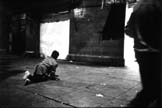KENT KLICH Street Children in Mexico City
KENT KLICH Street Children in Mexico City
| "Sometimes I can't help thinking that I would live better in jail than here on the streets. Before I was put in jail everybody told me that in jail you got beaten and raped. But they treated me good. Look at me now, I live dirty and alone. The little boys bring me food from time to time. In jail I got food three times a day, could watch TV, had my own bed and clean clothes." Mimí was sentenced to prison for being involved in a homocide. While in jail she became pregnant. Her son was simply called el Nino, the Child. |
|
When the children hear the train coming, they run outside the shed, jumping onto the platforms between the cars. The most courageous children hang upside down from the ironbars along the sides of the wagons. The slow-moving freight moves ponderously on followed by the dogs barking like crazy. |
|
In
1986, when I took the first photographs in this series I saw very few
infants and small children living on the streets. Since then society
has tacitly accepted the fact that the streets have become a place of
dwelling, inhabited by people of all ages. The children of the street
children are the first generation. |
. . . . . . . .
Muletas
crawls on all fours
to the store on Plaza Garibaldi

| Muletas
crawls on all fours to the store on Plaza Garibaldi. Not all the children
working on the streets are street children. Indian children, for example,
are always together with their parents and leave when darkness falls
to go home with their family. |
. . . . . . . .
|
Karateca
left home when he was eleven years old because his stepmother treated
him badly. Karateca asked his father to choose between him and the woman.
His father chose the woman.
|
|
|
|
|
|
|
|
|
|
|
|
|
|
|
||||||||